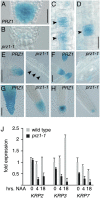Putative Arabidopsis transcriptional adaptor protein (PROPORZ1) is required to modulate histone acetylation in response to auxin
- PMID: 20479223
- PMCID: PMC2890463
- DOI: 10.1073/pnas.0913918107
Putative Arabidopsis transcriptional adaptor protein (PROPORZ1) is required to modulate histone acetylation in response to auxin
Abstract
Plant development is highly adaptable and controlled by a combination of various regulatory circuits that integrate internal and environmental cues. The phytohormone auxin mediates such growth responses, acting as a dynamic signal in the control of morphogenesis via coordinating the interplay between cell cycle progression and cell differentiation. Mutants in the chromatin-remodeling component PROPORZ1 (PRZ1; also known as AtADA2b) are impaired in auxin effects on morphogenesis, suggestive of an involvement of PRZ1-dependent control of chromatin architecture in the determination of hormone responses. Here we demonstrate that PRZ1 is required for accurate histone acetylation at auxin-controlled loci. Specifically, PRZ1 is involved in the modulation of histone modifications and corresponding adjustments in gene expression of Arabidopsis KIP RELATED PROTEIN (KRP) CDK inhibitor genes in response to auxin. Deregulated KRP expression in KRP silencer lines phenocopies prz1 hyperproliferative growth phenotypes, whereas in a KRP overexpression background some mutant phenotypes are suppressed. Collectively, our findings support a model in which translation of positional signals into developmental cues involves adjustments in chromatin modifications that orchestrate auxin effects on cell proliferation.
Conflict of interest statement
The authors declare no conflict of interest.
Figures




References
-
- de Kroon H, Huber H, Stuefer JF, van Groenendael JM. A modular concept of phenotypic plasticity in plants. New Phytol. 2005;166:73–82. - PubMed
-
- Gutierrez C. Coupling cell proliferation and development in plants. Nat Cell Biol. 2005;7:535–541. - PubMed
-
- Scheres B. Stem-cell niches: Nursery rhymes across kingdoms. Nat Rev Mol Cell Biol. 2007;8:345–354. - PubMed
-
- Skoog F, Miller CO. Chemical regulation of growth and organ formation in plant tissues cultured in vitro. Symp Soc Exp Biol. 1957;54:118–130. - PubMed
-
- De Veylder L, Beeckman T, Inzé D. The ins and outs of the plant cell cycle. Nat Rev Mol Cell Biol. 2007;8:655–665. - PubMed
Publication types
MeSH terms
Substances
LinkOut - more resources
Full Text Sources
Other Literature Sources
Molecular Biology Databases

